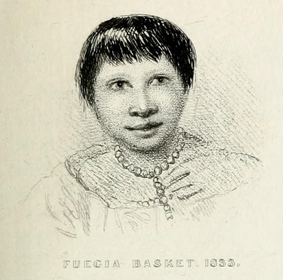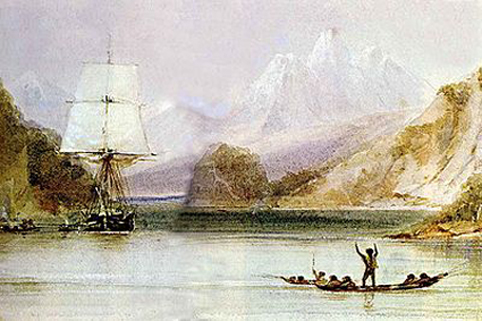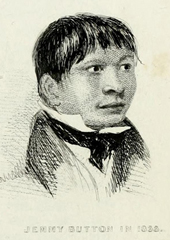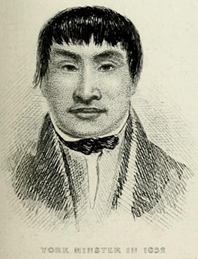Millennium Project
|
If Joseph Matthews' life was adventurous, his brother Richard's can only be described as "fantastical." Like his older brother, Richard became a missionary. His first task was to set up a Mission Station on Tierra del Fuego, an island off the southern tip of South America; a daunting challenge for a 21-year-old ! The Church Missionary Society arranged his passage on a naval vessel which was setting out on an expedition to observe, explore and survey "the southern shores of South America." The vessel was HMS Beagle, commanded by Captain Fitz-Roy; the expedition's naturalist was Charles Darwin. Both Fitz-Roy and Darwin kept extensive journals which were later published as Narratives, details of which are given at the end of this piece. These Narratives provide a full description of the attempt to found a Mission on Tierra del Fuego, a place which, at the time, was almost totally unknown to Europeans. |
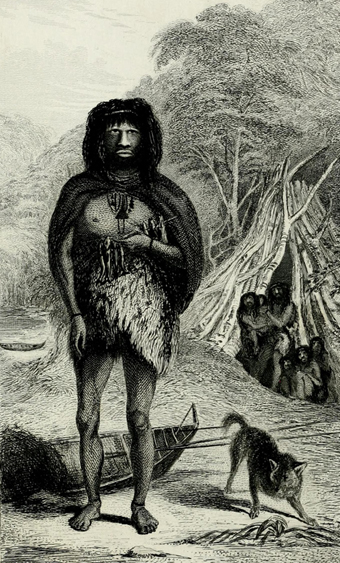 |
The Beagle set sail from Plymouth on November 27th 1831. One year later, as they were approaching Tierra del Fuego, an entry in Darwin's journal provides some background as to why Richard Matthews was on board.
"December 17th 1832. ...I have not as yet noticed [i.e. described] the Fuegians whom we had on board. During the former voyage of the Adventure and Beagle in 1826 to 1830, Captain Fitz-Roy seized on a party of natives, as hostages for the loss of a boat, which had been stolen, to the great jeopardy of a party employed on the survey; and some of these natives, as well as a child whom he bought for a pearl-button, he took with him to England, determining to educate them and instruct them in religion at his own expense. To settle these natives in their own country, was one chief inducement to Captain Fitz-Roy to undertake our present voyage; and before the Admiralty had resolved to send out this expedition, Captain Fitz-Roy had generously chartered a vessel, and would himself have taken them back."
The Beagle carried three native Fuegians who were returning home. The child Fitz-Roy purchased with a pearl button he named Jemmy Button. An older youth, York Minster, and a young woman, Fuegia Basket, completed the trio.
Fitz-Roy's Narrative contains transcripts of two letters from Mr. D. Coates, secretary to the Church Missionary Society, setting out the Society's expectations of Matthews, the three Fuegians and the Mission Station they were to create. Both are dated November 10, 1831, just prior to the Beagle's departure from Plymouth.
The first letter is addressed to Captain Fitz-Roy RN., the second, much longer one, is to Richard Matthews.
My Dear Sir.
Matthews left town this morning to join the Beagle at Plymouth, being detained till to-day for the steamer.
We have provided Matthews with all such articles as appeared to be necessary for him, and which could be most advantageously supplied in this country. These had all been completed before I learned from Mr. Wilson that you are short of stowage. I hope, however, they will not be found to amount to a quantity to occasion you inconvenience; and I think you will be of opinion that no part of his outfit could, with propriety, be dispensed with, in case Matthews becomes a permanent resident in Tierra del Fuego.
Mr. Wilson and myself concurred in opinion that a letter should be addressed by us to Matthews, in reference to the undertaking on which he is about to enter.... The letter is enclosed, and we shall feel obliged by your giving it to Matthews, when he comes on board. You will, of course, take a copy of it, if you wish to do so.
I much regret that we could not meet with a suitable companion for Matthews. I trust, however, you will find him to possess many valuable qualifications for the undertaking.
With very cordial wishes for your safety and welfare,
I remain, &c.D. COATES.
DEAR MR. MATTHEWS
The friends by whose means you are enabled to proceed to Tierra del Fuego cannot suffer you to depart without offering to you some suggestions and counsel with regard to your future course.
The undertaking in which you are about to be engaged springs from the benevolent interest taken by Captain Fitz-Roy in the natives of the island of Tierra del Fuego... Some of them were brought hither by Capt. F. on his return home, about twelve months ago. These individuals, through Capt. F.’s kind exertions, were, during their stay in England, placed under circumstances to receive instruction in the English language, in the principles of Christianity, and in some of the most simple arts of civilized life.
These natives will be your companions on board the “Beagle,” a passage to Tierra del Fuego having, at the instance of Capt. F., been granted to them and to you on board that ship, by the liberality of the Lords of the Admiralty.
Some Christian friends having become acquainted with these foreigners...have supplied the means of providing the outfit, which was requisite to enable you, advantageously, to enter on the work before you. Among these friends you are especially indebted to the kindness and liberality of the Rev. W. Wilson. His solicitude to forward Capt. Fitz-Roy’s views has been manifested toward these Fuegians, as well as yourself, by his having had them under his immediate care at Walthamstow for many months, in order to impart to them such knowledge and information as seemed calculated to promote their present and eternal welfare, and by contributing largely to the fund raised for your use......
Your first object must be to acquire the language of the Fuegians...In prosecution of this object, we recommend you carefully to note down in writing every new word which you hear. These vocabularies you will, at your leisure, classify and reduce to order, to form the basis of a grammar and dictionary, and ultimately of translations into the language....
In imparting religious instruction to the natives, you will make the Bible the basis of all your teaching. You must never lose sight of that great theological principle laid down in the sixth article of the Church of England: “That Holy Scripture containeth all things necessary to salvation; so that whatsoever is not read therein, nor may be proved thereby, is not to be required of any man that it should be believed as an article of the faith, or be thought requisite or necessary to salvation.” ...
In your intercourse with the Fuegians, you will bear in mind that it is the temporal advantages which you may be capable of communicating to them that they will be most easily and immediately sensible of. Among these may be reckoned the acquisition of better dwellings, and better and more plentiful food and clothing. Consequently, you will consider it a primary duty to instruct them in cultivating the potato, cabbage, and other vegetables; to rear pigs, poultry, &c., and to construct a commodious habitation, &c. You will probably find in this, as well as in more important things, that example is the most influential instructor. You must therefore take care to have a comfortable habitation yourself, furnished with all necessary articles for use, and kept clean and orderly. You will also fence in a piece of ground for a garden, and get it well stocked with the most useful vegetables; and also surround yourself as quickly as possible with a plentiful supply of pigs, poultry, goats, &c. This, indeed, you will find absolutely necessary for your own future subsistence, as well as with a view to the civilization and comfort of the natives.
Captain Fitz-Roy will, we doubt not, afford you assistance in selecting a proper spot for your residence, and raising a dwelling upon it; and also in procuring the requisite seeds and animals for your subsistence, and for the successful prosecution of your work. A very liberal supply of European clothing, implements and tools, ironmongery, earthenware, &c., is included in your outfit.
We trust that these general hints, with the information and assistance which you may acquire from Captain Fitz-Roy and the books with which you are supplied, will suffice to enable you to carry on your work with comfort and efficiency.
You will have the kindness to write to Mr. Wilson, with full particulars of your proceedings and prospects, by every practicable opportunity, sending your letters to Buenos Ayres, or any other point where they may be likely to get into a channel to reach England.
In conclusion, I have only to add that Captain Fitz-Roy has very kindly and considerately offered to bring you back with him to this country, should circumstances, contrary to our anticipations, turn out to be such that you should deem it unadvisable to remain at Tierra del Fuego.
Earnestly praying that the blessing of God may rest on you and your important and interesting labours,
I remain, truly yours,D. COATES.
At this distance, Mr. Coates' instructions to Richard Matthews look to be very unrealistic. As it turned out, they were optimistic in the extreme. And, as we will see, the "outfit" that the CMS provided to help Matthews in his work was indubitably "not fit for purpose."
The Arrival
The events in Tierra Del Fuego are best described by Captain Fitz-Roy through his Narrative:
Dec 18th [1832]: Mr. Darwin, Mr. Hammond and others went with me to the natives who so vociferously greeted our arrival; and deeply indeed was I interested by witnessing the effect caused in their minds by this first meeting with man in such a totally savage state...
Richard Matthews was with us, but did not seem to be at all discouraged by a closer inspection of these natives. He remarked to me, that they were no worse than he supposed them to be."
Darwin makes some pithy comments in his Journal about the items that the CMS had sent for Matthews' use at the Mission Station:HMS Beagle in Tierra del Fuego
Watercolour by Conrad Martens, ship's draughtsmanJanuary 18th [1833]: Having moored the Beagle in security, and made arrangements for the occupation of those who were to remain on board, I set out with four boats (yawl and three whaleboats), carrying Matthews and the Fuegians, with all the stock of useful things which had been given to them in England. A temporary deck having been put upon the yawl, she carried a large cargo [far the larger part of their property, including Matthews outfit, was sent by Mr. Coates, Secretary of the Church Missionary Society], and was towed by the other boats when the wind was adverse. Matthews showed no sign of hesitation or reluctance; on the contrary, he was eager to begin the trial to which he had been so long looking forward. Messrs. Darwin, Bynoe, Hamond, Stewart, and Johnson, with twenty-four seamen and marines, completed the Party.
My intention was to go round the northeast part of Navarin Island...to the spot which Jemmy called his country; there establish the Fuegians, with Matthews:—leave them for a time, while I continued my route westward to explore ….and at my return thence decide whether Matthews should be left among the natives for a longer period, or return with me to the Beagle...I was much gratified by seeing that Matthews still looked at his hazardous undertaking as steadily as ever, betraying no symptom of hesitation..
January 19th, 1833: The choice of articles showed the most culpable folly & negligence. Wine glasses, butter-bolts, teatrays, soup turins, mahogany dressing case, fine white linen, beavor hats & an endless variety of similar things shows how little was thought about the country where they were going to. The means absolutely wasted on such things would have purchased an immense stock of really useful articles.
Setting up the Mission
On January 23rd. 1833, the party arrived at "Woollÿa," the place they planned to build the Mission:
This first evening of our stay at Woollÿa was rather an anxious one; for although the natives were inclined to be quite friendly...it was hard to say what mischief might not be planned by so numerous a party, fancying, as they would, that we were inferior to them in strength, because so few in number. Jemmy passed the evening with his mother and brothers…York...and Fuegia were going about among the natives at their wigwams, and the good effect of their intercourse and explanations, such as they were, was visible next day (24th) in the confident, familiar manner of the throng which surrounded us while we began to dig ground for gardens, as well as cut wood for large wigwams, in which Matthews and his party were to be established. Canoes still arrived, but their owners seemed as well disposed as the rest of the natives, many of whom assisted us in carrying wood, and bringing bundles of grass or rushes to thatch the wigwams which they saw we were making, in a pleasant sheltered spot, near a brook of excellent water. One wigwam was for Matthews, another for Jemmy, and a third for York and Fuega.
A small plot of ground was selected near the wigwams, and, during our stay, dug, planted and sowed with potatoes, carrots, turnips, beans, peas, lettuce, onions, leeks, and cabbages….
Darwin appears to see Matthews in a totally different light to Fitz-Roy, noting in his journal:7th. [February] While a few of our party were completing the thatch of the last Wigwam, and others were digging in the garden which was made, I was much surprised to see that all the natives were preparing to depart; and very soon afterwards every canoe was set in motion,—not half a dozen natives remaining….I was in much doubt as to the cause. Whether an attack was meditated, and they were removing the women and children, previous to a general assembly of the men, or whether they had been frightened by our display on the preceding evening, and feared that we intended to attack them, I could not ascertain; but deeming the latter by far the most probable, I decided to take the opportunity of their departure to give Matthews his first trial of passing a night at the new wigwams.
Fitz-Roy's narrative continues:Matthews & his companions prepared to pass an aweful night. Matthews behaved with his usual quiet resolution: he is of an eccentric character & does not appear (which is strange) to possess much energy & I think it very doubtful how far he is qualified for so arduous an undertaking.
In the evening, Matthews and his party—Jemmy, York, and Fuegia—went to their abode in the three new wigwams.....[Matthews' wigwam] was high and roomy for such a construction; the space overhead was divided by a floor of boards, brought from the ship, and there most of Matthews' stores were placed; but the most valuable articles were deposited in a box, which was hid in the ground underneath the wigwam, where fire could not reach.
Matthews was steady, and as willing as ever; neither York nor Jemmy had the slightest doubt of their being all well-treated; so trusting that Matthews, in his honest intention to do good, would obtain that assistance in which he confided, I decided to leave him for a few days. The absence of the natives, every one of whom had decamped at this time, gave a good opportunity for landing the larger tools belonging to Matthews and our Fuegians and placing them within or beneath his wigwam, unseen by anyone except ourselves; and at dusk, all that we could do for them being completed we left the place and sailed some miles to the southward.
During the four days in which we had so many natives about us, of course some thefts were committed, but nothing of consequence was stolen..…Our people lost a few trifles, in consequence of their own carelessness. Had they themselves been left among gold and diamonds, would they all have refrained from indulging their acquisitive inclinations?
Notwithstanding the decision into which I had reasoned myself respecting the natives, I could not help being exceedingly anxious about Matthews, and early next morning our boats were again steered towards Woollÿa. My own anxiety was increased by hearing the remarks made from time to time by the rest of the party, some of whom thought we should not again see him alive; and it was with no slight joy that I caught sight of him, as my boat rounded a point of land, carrying a kettle to the fire near his wigwam. We landed and ascertained that nothing had occurred to damp his spirits, or in any way check his inclination to make a fair trial. Some natives had returned…..but so far were they from showing the slightest ill-will, that nothing could be more friendly than their behaviour..…
A further trial was now determined upon. The yawl, with one whale-boat, was sent back to the Beagle, and I set out on a westward excursion, accompanied by Messrs. Darwin and Hamond, in the other two boats: my intention being to complete the exploration....then revisit Woollÿa, either leave or remove Matthews, as might appear advisable…..
Mission Impossible
February 4th 1833, Fitz-Roy returned to see Matthews' progress:
Jemmy Button, York Minster and Fuegia Basket were left behind to pick up their Fuegian lives …... at noon reached Woollÿa. Several canoes were on the beach, and as many natives seemed to be assembled as were there two days before we left the place. All were much painted, and ornamented with rags of English clothing, which we concluded to be the last remnants of our friends’ stock. Our boats touched the shore; the natives came hallooing and jumping about us, and then, to my extremerelief, Matthews appeared, dressed and looking as usual..…
Taking Matthews into my boat, we pushed out a short distance to be free from interruption, and remained till I had heard the principal parts of his story… Nearly all the Fuegians squatted down on their hams to watch our proceedings, reminding me of a pack of hounds waiting for a fox to be unearthed.
Matthews gave a bad account of the prospect which he saw before him, and told me, that he did not think himself safe among such a set of utter savages as he found them to be…No violence had been committed beyond holding down his head by force, as if in contempt of his strength; but he had been harshly threatened by several men, and from the signs used by them, he felt convinced they would take his life. During the last few days, his time had been altogether occupied in watching his property. At first there were only a few quiet natives about him, who were inoffensive; but three days after our departure several canoes full of strangers to Jemmy’s family arrived, and from that time Matthews had had no peace by day, and very little rest at night. Some of them were always on the look-out for an opportunity to snatch up and run off with some tool or article of clothing, and others spent the greater part of each day in his wigwam, asking for every thing they saw, and often threatening him when he refused to comply with their wishes. More than one man went out in a rage, and returned immediately with a large stone in his hand, making signs that he would kill Matthews if he did not give him what was demanded. Sometimes a party of them gathered round Matthews, and, if he had nothing to give them, teased him by pulling the hair of his face, pushing him about, and making mouths at him.... Fortunately, the most valuable part of Matthews’ own things were underground, in a cave unsuspected by the natives, and other large tools were hidden overhead in the roof of his hut….Our garden, upon which much labour had been bestowed, had been trampled over repeatedly.
....It was soon decided that Matthews should not remain. I considered that he had already undergone a severe trial, and ought not to be again exposed to such savages, however willing he might be to try them farther if I thought it right. The next difficulty was how to get Matthews’ chest and the remainder of his property safely into our boats, in the face of a hundred Fuegians, who would of course understand our object, and be much more than a match for us on land, but the less hesitation shown, the less time they would have to think of what we were about; so, dividing our party, and spreading about a little to create confidence—at a favourable moment the wigwam was quickly cleared, the cave emptied, and the contents safely placed in our boats….
When fairly out of sight of Woollÿa, sailing with a fair wind towards the Beagle, Matthews must have felt almost like a man reprieved, excepting that he enjoyed the feelings always sure to reward those who try to do their duty, in addition to those excited by a sudden certainty of his life being out of jeopardy….
A few days later, Fitzroy returned to make sure "his" Fuegians were settled:
Several canoes were out fishing, women only being in them, who did not cease their occupation as we passed: this augered well; and in a few minutes after we saw Jemmy, York and Fuegia in their usual dress. But few natives were about them, and those few seemed quiet and well disposed. Jemmy complained that the people had stolen many of his things but York and Fuegia had contrived to take better care of theirs. I went to their wigwams and found very little change. Fuegia looked clean and tidily dressed, and by her wigwam was a canoe, which York was building out of planks left for him by our party, the garden was uninjured and some of the vegetables already sprouting.
… finding that they were all quite contented and apparently very happy, I left the place, with rather sanguine hopes of their effecting among their country men some change for the better..…I hoped that through their means our motives in taking them to England would become understood and appreciated among their associates, and that a future visit might find them so favourably disposed towards us, that Matthews might then undertake, with a far better prospect of success, that enterprise which circumstances had obliged him to defer though not to abandon altogether.
New Zealand
It took the Beagle, and Richard Matthews, almost two years to reach New Zealand after leaving Tierra del Fuego. The Galapagos Islands was perhaps the most famous of their many ports of call en-route. On the 28th of December 1835 Fitz-Roy visited Waimate, the agricultural establishment of the Church Missionary Society in New Zealand. There he met with some of the senior members.
So it was that Richard Matthews joined his brother Joseph at the Kaitaia Mission. He married Johanna Blomfield in 1838 and in 1840 the CMS asked him to assist in setting up a mission station at Wanganui, which he did. There is some suggestion that he later had a disagreement with the CMS and returned to Kaitaia. He died in 1893 at the age of 82 years.… It was also very gratifying to me to mark the lively interest taken by Mr. Williams, Mr. Davis, and Mr. Baker in every detail connected with the Fuegians, and our attempt to establish Richard Matthews in Tierra del Fuego. Again and again they recurred to the subject, and asked for more information ; they would not hear of in calling the attempt ‘a failure.’ “It was the first step,” said they, “and similar in its result to our first step in New Zealand. We failed at first ; but, by God’s blessing upon human exertions, we have at last succeeded far beyond our anticipations.” Their anxiety about the South American aborigines generally ; about the places where missionaries might have a chance of doing good; and about the state of the islands in the Pacific Ocean, gave me a distinct idea of the prevalence of true rnissionary spirit.…..
At this interview it was fully decided that Richard Matthews should remain with his brother, a respectable young missionary mechanic, established at the northern end of the Island, and lately married to Mr. Davis’s daughter…..With sincere regret I took leave of the residents at Waimate. Instead of hours, I could have passed days.
A Footnote
Richard Matthews' short-lived Mission on Tierra del Fuego was the most successful one for many years , the islands were visited only sporadically for some time after.
Captain Allen Gardiner attempted to found another Mission in 1851 but he and his companions starved to death..
In 1855 a group of Christian Missionaries from the Patagonian Missionary Society visited Wulaia Bay [Woollÿa] and met with Jemmy Button, who still had a remarkable grasp of English. Some time later, in 1859, another group of missionaries was killed at Wulaia by the Fuegians, supposedly led by Jemmy and his family. In early 1860 Jemmy gave evidence at the enquiry into the massacre, held in Stanley in the Falkland Islands. He denied responsibility.
In 1863 the Missionary Waite Stirling visited Tierra del Fuego and re-established contact with Jemmy. After Jemmy's death in 1866 Stirling took one of his sons, known as Threeboys, to England, and when he, Stirling, was made Bishop of the Falkland Islands, Threeboys returned with him. He is buried in Stanley Cemetery.
The full story of Richard Matthews can be found in Darwin's journal, published as "The Voyage of the Beagle" and Volumes II and III of the "Narrative of the surveying voyages of His Majesty's ships Adventure and Beagle between the years 1826 and 1836, describing their examination of the southern shores of South America and the Beagle's circumnavigation of the globe" written by Fitz-Roy and Darwin respectively.
These books and their associated lithographic plates are in the Public Domain and are available online through the Bio-diverity Heritage Library. Their capture as images was sponsored by the Natural History Museum Library, London.
The image of the watercolour by Conrad Martens (1801 - 1878) is in the Public Domain via Wikimedia Commons.
